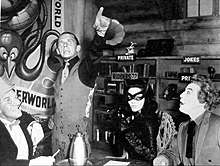Supervillain
A supervillain or supercriminal is a variant of the villainous stock character that is commonly found in American comic books, usually possessing superhuman abilities. A supervillain is the antithesis of a superhero. A female supervillain is sometimes called a supervillainess, although the word supervillain is also commonly used for females.
Supervillains are often used as foils to present a daunting challenge to a superhero. In instances where the supervillain does not have superhuman, mystical, or alien powers, the supervillain may possess a genius intellect or a skill set that allows him to draft complex schemes or commit crimes in a way normal humans cannot. Other traits may include megalomania and possession of considerable resources to further their aims. Many supervillains share some typical characteristics of real world dictators, gangsters, mad scientists, trophy hunters, corrupt businesspeople, serial killers, and terrorists, with aspirations of world domination or universal leadership.[1]
Notable supervillains
The Joker, Lex Luthor, Sinestro, Brainiac, Green Goblin, Loki, Thanos, Magneto, Venom, Red Skull, Doctor Doom, Deathstroke, Ra's al Ghul, and Darkseid are some notable male comic book supervillains and have been adapted to film and television.[2][3] Some notable examples of female supervillains are The Cheetah, Catwoman, Mystique, Harley Quinn, Talia al Ghul, Poison Ivy, Hela and Dark Phoenix.[4][5]
Just like superheroes, supervillains are sometimes members of supervillain groups, such as the Sinister Six, the Suicide Squad, the Brotherhood of Mutants, the Injustice League, the Legion of Doom, and the Masters of Evil.
In the documentary "A Study in Sherlock" Stephen Moffat and Mark Gatiss have claimed to regard James Moriarty as a supervillain because he too possesses genius level intelligence and powers of observation and deduction setting him above ordinary people to the point where only he can pose a credible threat to Sherlock Holmes.
The James Bond arch-villain Ernst Stavro Blofeld (known for frequently appearing sitting on an armchair while stroking his Persian cat and often leaving his face unseen to the viewer in screen appearances) has become influential to the supervillain tropes in popular cinema, including parodies like Dr. Claw and his pet M.A.D. Cat from the Inspector Gadget animated series, Dr. Evil and his cat Mr. Bigglesworth, from the Austin Powers film series or even Dr. Blowhole from the animated TV series The Penguins of Madagascar.
See also
- Archenemy
- Crime
- Rogues gallery
- List of Batman Family adversaries
- List of Superman enemies
- List of Spider-Man enemies
- List of Spawn villains
- Evil Overlord List
- Mad scientist
- List of comic book supervillain debuts
- List of female supervillains
- Lists of villains
References
- "Eury & Misiroglu On The Supervillain Book". Comicon.Com. Archived from the original on 2012-02-18. Retrieved 2012-05-09.
- "Joker tops supervillain poll". Metro.co.uk. 2012-04-25. Retrieved 2012-05-09.
- "Top Ten Comic Book Super Villains". Comicbooks.about.com. 2012-04-10. Retrieved 2012-05-09.
- "Lethal Ladies ; The 10 Best Female Supervillains". Newsarama.com. Retrieved 2013-10-22.
- "Maleficent and 16 Other Famous Queens of Mean". Time Magazine. Retrieved 2015-04-09.
External links


